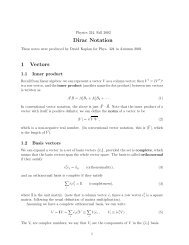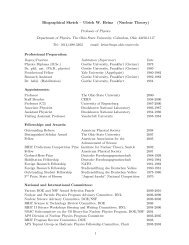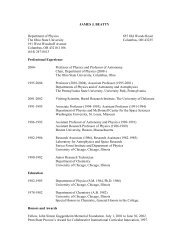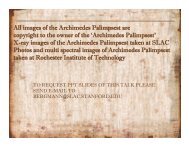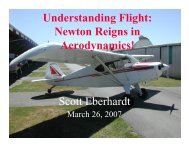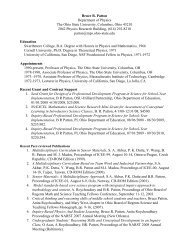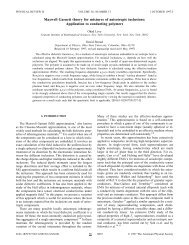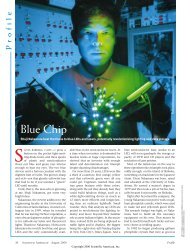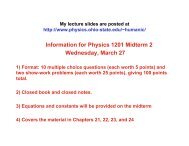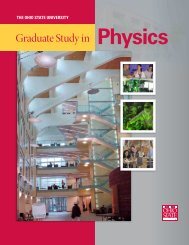Brasil Final Report - Department of Physics - The Ohio State University
Brasil Final Report - Department of Physics - The Ohio State University
Brasil Final Report - Department of Physics - The Ohio State University
You also want an ePaper? Increase the reach of your titles
YUMPU automatically turns print PDFs into web optimized ePapers that Google loves.
53<br />
<strong>The</strong> students in our classes are more diverse than they were twenty years ago, and more <strong>of</strong><br />
them will be ethnic minorities in the next twenty years. <strong>Physics</strong> has a poor track record in attracting<br />
ethnic minorities and women. <strong>The</strong> number <strong>of</strong> women who receive bachelor's degrees in physics has<br />
increased to nineteen percent but has remained nearly level for the last three years. Women<br />
currently earn more than half <strong>of</strong> all the bachelor's degrees in the life sciences and about forty percent<br />
<strong>of</strong> those in chemistry and mathematics. Many talented students share widespread perceptions that<br />
physics is not only an unexciting field in which to work but that all physicists are European males.<br />
Undergraduate physics departments must respond constructively and creatively to these<br />
changes in physics, the workplace, and undergraduate physics students. Fortunately undergraduate<br />
physics departments have several advantages as they face the future. First, they are made up <strong>of</strong><br />
physicists. Physicists are generally intelligent if a touch arrogant. <strong>The</strong>y take a "can do" approach<br />
and work hard if they are committed to a project.<br />
<strong>The</strong> job market for physics students has been very good for the last several years. In fact,<br />
the salaries <strong>of</strong>fered by industrial employers are so high that it is difficult to retain new high school<br />
physics teachers. Undergraduate enrollments have stabilized in the last two years, particularly in<br />
the bachelors-granting institutions. <strong>Physics</strong> graduates are widely recognized as good candidates for<br />
graduate or pr<strong>of</strong>essional school in a variety <strong>of</strong> disciplines as well as for jobs in industry. <strong>The</strong>y are<br />
nearly all hard-working and generally intelligent.<br />
Recent data indicate that 28% <strong>of</strong> high school students complete a course in physics, a<br />
significant increase from 20% ten years ago. This provides departments with better-prepared<br />
freshmen, but it implies that the introductory course in physics should not repeat material already<br />
covered in high school. Should the current trend towards teaching physics before chemistry or<br />
biology grow, the demand for secondary physics teachers will escalate and increase the existing<br />
shortage <strong>of</strong> well-prepared physics teachers.<br />
<strong>Final</strong>ly, over the last twenty years, a group <strong>of</strong> physicists within physics departments have<br />
undertaken the study <strong>of</strong> how students learn physics. <strong>The</strong>ir work has evolved into a subdiscipline <strong>of</strong><br />
physics, physics education research (PER). At present, PER has developed a body <strong>of</strong> knowledge<br />
about student learning <strong>of</strong> physics which has begun to form the base <strong>of</strong> new curricular material. <strong>The</strong><br />
research also indicates that students learn best when they are actively engaging the material rather<br />
than passively listening to a lecture. We know a lot about helping students learn physics, and we<br />
can improve our courses and make physics accessible to a wider variety <strong>of</strong> students. <strong>The</strong> research<br />
base on learning physics prepared within physics departments by physicists is unique to physics.<br />
It gives our discipline a major advantage.<br />
<strong>The</strong> physics community through its three major pr<strong>of</strong>essional associations, the American<br />
Association <strong>of</strong> <strong>Physics</strong> Teachers (AAPT), the American Physical Society (APS), and the American<br />
Institute <strong>of</strong> <strong>Physics</strong> (AIP), has recognized the need for change within undergraduate physics. <strong>The</strong><br />
three societies have organized conferences <strong>of</strong> physicists and department chairs to discuss the<br />
situation. From these activities, we have learned several lessons that will guide our efforts to<br />
respond to the changes in the environment <strong>of</strong> undergraduate physics.<br />
Physicists recognize that we need to take action to improve undergraduate physics, both for<br />
non-majors and for majors. <strong>The</strong> declining enrollments have alarmed even those who deal primarily<br />
with graduate students since enrollment in first year graduate programs has begun to reflect the<br />
declining number <strong>of</strong> undergraduate physics majors. AAPT, APS and AIP have jointly formed the<br />
National Task Force on Undergraduate <strong>Physics</strong> to determine the best strategy for revitalizing<br />
programs in undergraduate physics.




